
The longhorn beetles (Cerambycidae), also known as long-horned or longicorns, are a large family of beetles, with over 35,000 species described.

George Combe was a Scottish lawyer and a spokesman of the phrenological movement for over 20 years. He founded the Edinburgh Phrenological Society in 1820 and wrote The Constitution of Man (1828). After marriage in 1833, Combe devoted his later years to promoting phrenology internationally.

Castle Combe is a village and civil parish in Wiltshire, England. The village is around 5 miles (8 km) north-west of Chippenham and 10 miles (16 km) north-east of Bath. At the 2021 census, the parish had a population of 356.
A combe can refer either to a steep, narrow valley, or to a small valley or large hollow on the side of a hill.
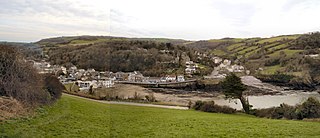
Combe Martin is a village, civil parish and former manor on the North Devon coast about 4 miles (6.4 km) east of Ilfracombe. It is a small seaside resort with a sheltered cove on the northwest edge of the Exmoor National Park.

Combe Raleigh is a village and civil parish in the county of Devon, England. The village lies about 1.5 miles north of the town of Honiton, and the parish is surrounded, clockwise from the north, by the parishes of Luppitt, Honiton, Awliscombe and Dunkeswell.
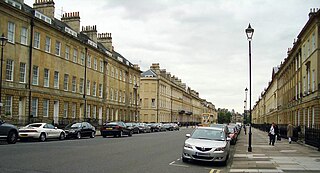
Bath Stone is an oolitic limestone comprising granular fragments of calcium carbonate originally obtained from the Middle Jurassic aged Great Oolite Group of the Combe Down and Bathampton Down Mines under Combe Down, Somerset, England. Its honey colouring gives the World Heritage City of Bath, England, its distinctive appearance. An important feature of Bath Stone is that it is a 'freestone', so-called because it can be sawn or 'squared up' in any direction, unlike other rocks such as slate, which form distinct layers.

Formula Ford 1600 is a group of auto racing championships for 1600cc Ford Kent powered Formula Ford racing cars. The UK national Formula Ford category disbanded these cars when it adopted the 1800cc Zetec engine in 1993. However, several regional club championships have continued to run.

Harptree Combe is a 13.63-hectare (33.68-acre) Site of Special Scientific Interest (SSSI) near East Harptree notified in 1954. "Combe" or "coombe" is a West Country word meaning a steep-sided valley. It is also the site of a 19th-century aqueduct and is overlooked by the site of a castle dating from around 1100.
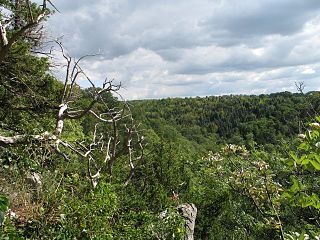
Goblin Combe is a dry valley in North Somerset which stretches for approximately 3½ km from Redhill, near Bristol International Airport on the A38, through to Cleeve on the A370. The combe is located at, and is a 52-hectare (128-acre) biological Site of Special Scientific Interest (SSSI) originally notified in 1999, with 9 hectares being managed as a nature reserve by the Avon Wildlife Trust. The Combe runs along the southern edge of a large woodland. "Combe" is the same as the Welsh word "cwm" which means valley.
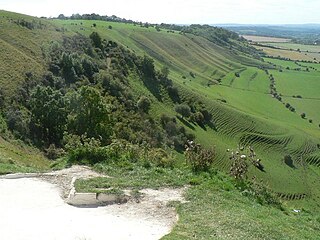
Bratton Downs is a 395.8 hectare biological and geological Site of Special Scientific Interest in Wiltshire, England, near the villages of Bratton and Edington, and about 3 miles (5 km) east of the town of Westbury. It was notified in 1971. The designated area consists mainly of chalk grassland, as well as some ancient woodland, and supports a diverse range of native flora and fauna. It overlays notable geological features—principally landforms created by glaciation in the Pleistocene.

Castle Combe Circuit is a motor racing circuit in Wiltshire, England, approximately 20-mile (32 km) from Bristol. The circuit is based on the perimeter track of a former World War II airfield, and was opened for racing in 1950.
Future Academies Watford is a co-educational secondary school and sixth form located in Garston, Watford, Hertfordshire, England.
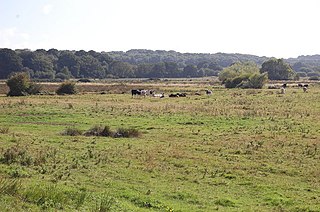
Combe Haven is a 153-hectare (380-acre) biological Site of Special Scientific Interest between Hastings and Bexhill-on-Sea in East Sussex. An area of 18.5 acres is Filsham Reedbed Local Nature Reserve, which is managed by the Sussex Wildlife Trust

Dorcasominae is a subfamily in the longhorn beetle family Cerambycidae. There are about 14 genera and more than 30 described species in Dorcasominae, found mainly in Asia and Africa. These genera are sometimes considered members of the tribe Dorcasomini, which would be the only tribe of this subfamily. This classification is in accordance with the TITAN Cerambycidae database, Catalogue of Life, and Photographic Catalog of the Cerambycidae of the Old World. It is similar to that of Bouchard et al. in "Family-group names in Coleoptera", 2011.

Radnor House Sevenoaks School is a coeducational private day school located in Sundridge in the English county of Kent.

Plocaederus is a genus of Long-Horned Beetles in the beetle family Cerambycidae. This genus has a single species, Plocaederus bellator. It is known from the South American countries Brazil, Ecuador, Guyana, French Guiana, Paraguay, and Suriname.
Lepturgantes is a genus of beetles in the family Cerambycidae. The genus is placed in subfamily Lamiinae and tribe Acanthocinini.

Filsham Reedbed is an 18.5-hectare (46-acre) Local Nature Reserve on the western outskirts of St Leonards-on-Sea in East Sussex. It is owned by Hastings Borough Council and managed by Sussex Wildlife Trust. It is part of Combe Haven Site of Special Scientific Interest.
















